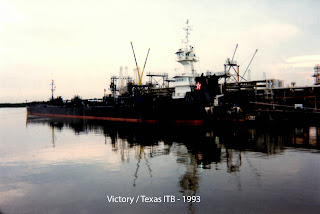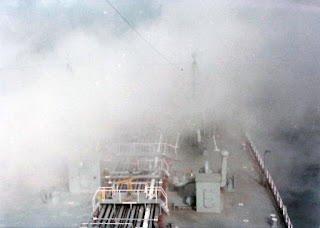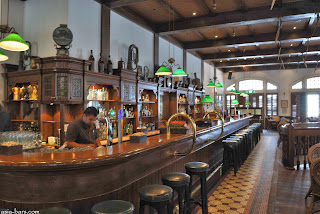In April 1977, I was assigned as 2nd Mate on the
California. A month on the
California was followed by 3 months on he
Connecticut, the first 2 months as Chief Mate, the last as 2nd Mate. Maurice Eaton was the skipper on the
Connecticut for the first few of voyages while Capt. Healey was on paid leave. We made 3 consecutive trips to the Caribbean, 2 to Trinidad and one to La Estacada, Venezuela. La Estacada was a submarine mooring in the port of Maracaibo. During our stay there, armed troops patrolled our deck. It was a bit unnerving. It didn't deter the two cadets from one of the state maritime colleges from taking a launch ashore and stealing some jewelry, as was reported to me by the 3rd Mate who witnessed the shoplifting incident. One of the cadets was a girl who distracted the shop keeper with her low cut blouse while the other cadet filched the jewelry. It was an incredibly stupid act since they would have still been in jail there had they been caught.
 |
| Texaco Connecticut |
The discharge port for the Venezuelan cargo, Lago Media Crude, was Portland Pipeline, ME. From there it was back to Trinidad to offload Light Arabian Crude from the
Texaco Ireland, a VLCC, my first lightering experience. Our discharge port was Delaware City. The parade of new ports continued as we next loaded at Garyville, LA for Piney Point, MD. From Piney Point we drove to Baltimore, about 3 hours away, with Capt. Healey, who had just rejoined. On the way back to the ship we stopped for dinner and I had my first taste of Maryland crab cakes - quite good. I stayed on the
Connecticut until the end of August and then went on paid leave for 2 months.
Lightering from Texaco Ireland
My next stint was on 3 vessels, the
Texaco Maryland,
Texaco Montana and
Texaco Wisconsin. The first 2 voyages were normal US Gulf to USNH. The next 2 months were spent in the Northeast, loading in Delaware City for points North. I really liked the run. We were extremely busy but got frequent breaks because we had a relief Mate in most ports. My wife would bring the kids down to Delaware City, and I could get home from Bayonne. We even made a trip into Newington (Portsmouth), NH near where my parents lived so I got to see them. They called it a "happening" when any ship came into Portsmouth. Our voyage there turned in to a real happening. There is a strong current that flows through Portsmouth Harbor. Ships must dock on slack water. Because we were fully loaded, we had to dock on high water slack. We arrived off Portsmouth several hours early and had to anchor to await the tide. Usually anchoring a ship is not problematic. Not so that day. I was stationed on the bow with the bosun and AB. It is easy to tell when it's time to drop the anchor. One looks over the side at the propeller wash and when it reaches the midships house, you know that the ship is stopped and beginning to make sternway. The captain called on the walkie-talkie to let go the port anchor. I had been checking the propeller wash and saw none so I did not release the anchor brake. After a minute of seeing no action from me on the bow, the captain radioed back to let go the anchor. I responded that we seemed to still have headway. He said to drop anchor anyway which I then did. As soon as the anchor hit the bottom it took a strong lead aft. We tried putting on the brake but couldn't fight the pull on the chain. The anchor ran out 10 shots and hesitated momentarily. I quickly ran over and threw down the riding pawl. I thought the pawl was going to be ripped from the deck. The chain jumped wildly but the anchor finally held and the strain eased up. Turns out the captain had the ship half ahead instead of half astern when he told me to let go, and that's only half the story. When it came time to heave up and pick up the harbor pilot, the captain failed to allow extra time to heave in the extra shots of chain we had out. We were late to the pilot station and by the time we had arrived at the dock, the tide was already starting to ebb. We put out every line we had but couldn't hold the ship alongside. As soon as the tide had dropped enough that we touched bottom, the ship slid sideways 30 feet off the dock. We had to use 5 tug boats to hold us there until the next flood tide raised us off the bottom and back alongside. The most embarrassing thing for me was that my parent's next door neighbor was himself a ship's captain with Moore McCormack lines. He went out in his boat to watch us anchor and later told me, good-naturedly, that it was the worse display of seamanship he'd ever seen. We had to replace the windlass brake assembly at no small cost. I had hoped to be able to spend more time with my parents but it turned in to a short visit. I did have time to buy the ship a good-sized Christmas tree which we mounted on the foremast and sailed around with for the next month.
 |
| Texaco Maryland - Call sign KADG |
Several other incidents of note occurred during my time on the
Maryland. On one trip from Delaware City north, we encountered a full gale. The ship rolled heavily in 20 foot seas. As we neared the Nantucket Lightship, we received a call from the USCG asking us to stop alongside the lightship and pick up a crewman who's wife was about to give birth. On a calm day, this could have been accomplished by ship to ship launch but there was no way this was going to happen in a full gale. We were surprised by the request and had to decline.
Another trip into Boston we had a split discharge. We first docked at the White Fuel terminal. Port relief was provided. The 2nd Mate, having the afternoon watch off, went to the horse track and won big. He celebrated by having a lobster dinner and way too much to drink. When it came time for us to shift over to the Chelsea terminal, the 2nd Mate wouldn't get out of bed. No way, shape or form was he going to get up for the shift and he didn't care. The captain decided to take matters into his own hands. He went in to the 2nd Mate's room, grabbed him by the arm and tried to pull him out of bed. The 2nd Mate grabbed on to the bed frame and resisted. It was a stalemate. When the captain threatened to fire him, the 2nd Mate replied that if he was fired, he'd tell the company that the ship had touched bottom coming down the Delaware River last trip and the captain hadn't reported it. On hearing this, the captain let go of the 2nd Mate's arm and left the room. The 2nd Mate stayed in bed for the shift and the subject never came up again. Although the actions of the captain and 2nd Mate were totally unprofessional, in the heat of the moment this was one of the most hilarious scenes I have ever witnessed on a ship.
The next trip into Chelsea, we had an engine crewman go into diabetic shock. He had been ashore drinking then came back and took a nap before going on watch. When he was called for his watch, he couldn't be woken up. The Captain was called and I responded with him. We called for an ambulance. When the medics arrived, they used what I thought was an unusual method to wake him. They said they had to cause him pain so they grabbed his leg and squeezed as tightly as they could. It worked. He woke up and was hospitalized overnight, returning to the ship the next day fit for duty.
When the
Maryland was due to head back to the US Gulf, I was transferred to the
Montana which was replacing the
Maryland on the Delaware City run. This was great because I was so familiar with the run. Capt. Stan Brownley was the skipper. He did most of the piloting himself and I learned a lot observing him. Unfortunately, after 2 weeks on the
Montana, the regular Chief Mate rejoined. He had been on sick leave. This Mate, CG, was the southern gentleman I had mentioned in an earlier assignment on the
Montana, who did not have the best grasp of the cargo system. I knew he'd have difficulty on the Delaware City run because of the short turnarounds. I called the Port Arthur office multiple times to try to explain that the Mate would not be able to handle this assignment because of his age. The assignment clerk, LP, was sure I was calling because I didn't want to go down to 2nd Mate on the
Wisconsin, where she was assigning me for the next month. Not so. The captain and chief engineer begged me to keep calling and I did one last time, again in vain. I'm sure LP wishes she had listened to me because a week later, CG died aboard the
Montana in Delaware City. As I had tried to tell her, the job had been too much for him.
I joined the
Wisconsin in Baytown, TX. Our first voyage was to Boston and Philadelphia. For the rest of my assignment, we stayed in the northeast, carrying #6 Fuel. It was a nasty winter. I remember being anchored in New York Harbor, in a blizzard, watching cars trying to unsuccessfully navigate the hilly streets of Staten Island. Meanwhile, our decks were dry as a bone what with the heated cargo. We made one trip up the Hudson River to Rensallaer. There must have been three feet of snow on the ground there. I remember Dick Halluska, the 3rd Mate who was in great shape, come out on deck after watch and point to a water tower high on a far hill. "I'm going to run up there" he said and sure enough off he went through the snowdrifts and was successful in his run.
The next 2 trips were in to the United Illuminating power plant in Bridgeport, CT. I had spent a year of college there but never got the chance to go ashore due to the blizzard weather. I clearly remember standing watch in pelting snow conditions and icicles forming on my beard.
The storms that winter were extremely severe, with one storm causing the sinking of the Interport Pilot boat off New York, with loss of life involved. We were anchored off of Boston at the time and I remember thinking that the anchor chain was going to part because of the large swells that kept jerking us around the anchorage.
I was able to do a lot of studying during my time on the
Wisconsin. During my next paid leave, I earned my Master's license.
 |
| Texaco Rhode Island |
My next ship was the Texaco Rhode Island, relieving Andy Chester as Chief Mate in Houston. Bill (Willy) Cubbage was the Master. Our first few voyages were to Tampa and Port Everglades. On one of the trips to Tampa, Capt. Cubbage, who lived in Big Pine Key, FL had his wife drive up. It was a weekend and he wanted a good stay in port so he told me he had heard that we were going to load a full load of Jet Fuel the next voyage and instructed me to wash and fresh water rinse all the tanks after we had finished discharging. When in port over a weekend, union rules dictated that if the ship was going to sail before Monday morning at 8AM, that the sailing board had to be posted soon after docking. Capt. Cubbage had no intention of sailing before Monday and told me not to post the board. We wound up staying alongside an extra full day after completing discharge just so Capt. Willy could have time ashore. The dock was furious because we were holding up a barge that was waiting for the berth. Meanwhile, I got all 27 tanks washed and rinsed. We wound up loading only 6 tanks with Jet Fuel the next trip.
On the next trip into Port Everglades, a man from the Texaco Industrial Hygene Dept. showed up and took air samples around the deck during the cargo operations. I asked him what he was sampling for but he wouldn't answer. It was quite strange. We all believed he was sampling for benzene and this belief was borne out when Texaco instituted a respiratory protection policy several years later.
The rest of the summer on the Rhode Island, we made trips to USNH (US North of Hatteras) ports. Kaare Hegna relieved Bill Cubbage as Master. I had never met Capt. Hegna before but I had heard what a well-liked man he was. Unfortunately, Capt. Hegna had recently had a hip replaced and was still in considerable pain. He resorted to taking strong pain killers, slept alot during the day and several times was not able to be woken up to come to the bridge when picking up the harbor pilots on arrival in port. It was good experience for me to maneuver the ship on arrival but it was not as it should have been. It happened two ports in a row and in both instances the pilots wanted to know where the captain was. I went on paid leave shortly thereafter, passing on this information to my relief. I later found out that Capt. Hegna retired soon thereafter due to his painful condition.
I'm going to jump ahead here although I do want to mention one incident along the way. I was on the bow of
the Maryland docking at the Loup. While heaving up the mooring lines. a
cottonmouth moccasin wrapped itself around one of the lines and was
heaved up onto the focslehead deck. Luckily one of the seamen saw the snake
coming. As soon as the snake landed on deck, it tried to strike the
closest man. He was prepared and belted the snake with a stopper line
and beat it to death. I could never have imagined that one day we'd
have to fight snakes while docking a ship.
A disc condition in my back called spondylolisthesis that I had been dealing with for a while became worse during my next paid leave. I tried to continue sailing as Chief Mate but found it physically difficult to work 16 hours days while taking muscle relaxers. I requested and was granted a temporary assignment in the Bayonne Marine office. There were some really good employees there: Dick Mikolon, Tom Summers, Jack Trainor, Buzz Whiting, Maureen Moy, Fred Johnson, Janice, John Boyle, and Tom Bicknell to name a few. I worked on all sorts of different projects from drawing pipeline diagrams for the inland barge units, to helping Fred with small fleet shipyard repairs, to going on the road to supervise "squeeze dry" operations in which ships going off charter were required to strip and restrip all the cargo from their tanks. John Boyle nicknamed me "Capt. Squeeze" at the time. Most of the squeeze dry work was local but I did get to do one job in Halifax, the first time I had visited the beautiful province of Nova Scotia where my parents had been stationed in WWII. After my assignment in the Bayonne office came to an end and not wanting to rely on medicine to mask my disc problem, as I had witnessed Capt. Hegna try unsuccessfully to do, I decided I would be better served by voluntarily going back to sea as 2nd Mate so I wouldn't need meds to function. Luckily, I was assigned to the Texaco California with a crew that was as outstanding as any ship in the fleet.





































